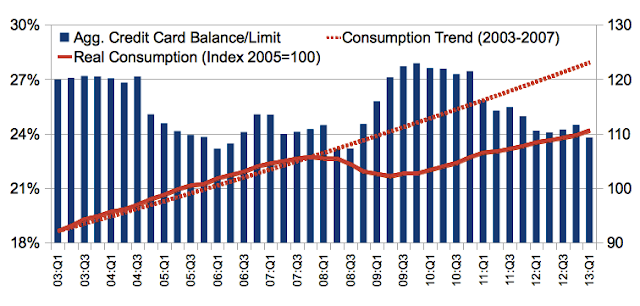Via John Cochrane, here is a great example. In the NBER Macroeconomics Annual a couple years ago, Gauti Eggertson laid out the canonical New Keynesian case for the effectiveness of fiscal policy when interest rates are at the Zero Lower Bound. In the model Eggertson describes there -- the model that is supposed to provide the intellectual underpinnings for fiscal stimulus -- the multiplier on government spending at the ZLB is indeed much larger than in normal conditions, 2.3 rather than 0.48. But the same model says that at the ZLB, cuts in taxes on labor are contractionary, with a multiplier of -1. Every dollar of "stimulus" from the Making Work Pay tax credit, in other words, actually reduced GDP by a dollar. Or as Eggertson puts it, "Cutting taxes on labor ... is contractionary under the circumstances the United States is experiencing today. "
Now, obviously there are reasons why one might believe this. For instance, maybe lower payroll taxes just allow employers to reduce wages by the same amount, and then in response to their lower costs they reduce prices, which is deflationary. There's nothing wrong with that story in principle. No, the point isn't that the New Keynesian claim that payroll tax cuts reduce demand is wrong -- though I think that it is. The point is that nobody actually believes it.
In the debates over the stimulus bill back at the beginning of 2009, everyone agreed that payroll tax cuts were stimulus just as much as spending increases. The CBO certainly did. There were plenty of "New Keynesian" economists involved in that debate, and while they may have said that tax cuts would boost demand less than direct government spending, I'm pretty sure that not one of them said that payroll tax cuts would actually reduce demand. And when the payroll tax cuts were allowed to expire at the end of 2012, did anyone make the case that this was actually expansionary? Of course not. The conventional wisdom was that the payroll tax cuts had a large, positive effect on demand, with a multiplier around positive 1. Regardless of good New Keynesian theory.
As a matter of fact, even Eggertson doesn't seem to believe that raising taxes on labor will boost demand, whether or not it's what the math says. The "natural result" of his model, he admits, is that any increase in government spending should be financed by higher taxes. But:
There may, however, be important reasons outside the model that suggest that an increase in labor and capital taxes may be unwise and/or impractical. For these reasons I am not ready to suggest, based on this analysis alone, that raising capital and labor taxes is a good idea at zero interest rates. Indeed, my conjecture is that a reasonable case can be made for a temporary budget deficit to finance a stimulus plan...Well, yeah. I think most of us can agree that raising payroll taxes in a recession is probably not the best idea. But at this point, what are we even doing here? If you're going to defer to arguments "outside the model" whenever the model says something inconvenient or surprising, why are you even doing it?
EDIT: I put this post up a few days ago, then took it down because it seemed a little thin and I thought I would add another example or two of the same kind of thing. But I'm feeling now that more criticism of mainstream economics is not a good use of my time. If that's what you want, you should check out this great post by Noah Smith. Noah is so effective here for the same reason that he's sometimes so irritatingly wrong -- he's writing from inside the mainstream. The truth is, to properly criticize these models, you have to have a deep knowledge of them, which he has and I do not.
Arjun and I have a piece in an upcoming Economics and Politics Weekly on how liberal, "saltwater" economists share the blame for creating an intellectual environment favorable to austerian arguments, however much they oppose them in particular cases. I feel pretty good about it -- will link here when it comes out -- I think for me, that's enough criticism of modern macro. In general, the problem with radical economists is they spend too much time on negative criticism of the economics profession, and not enough making a positive case for an alternative. This criticism applies to me too. My comparative advantage in econblogging is presenting interesting Keynesian and Marxist work.
One thing one learns working at a place like Working Families, the hard thing is not convincing people that shit is fucked up and bullshit, the hard thing is convincing them there's anything they can do about it. Same deal here: The real challenge isn't showing the other guys are wrong, it's showing that we have something better.

